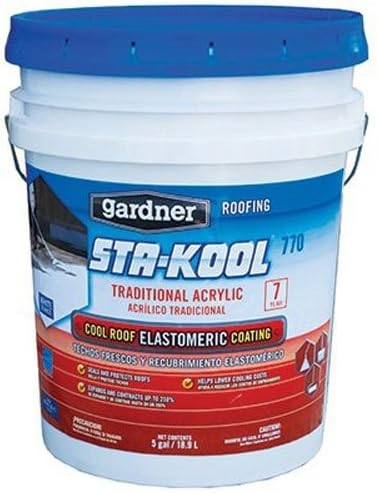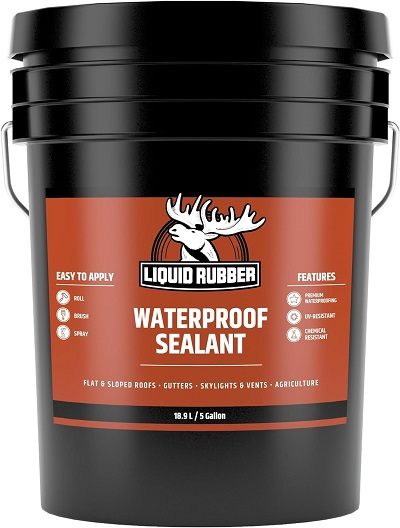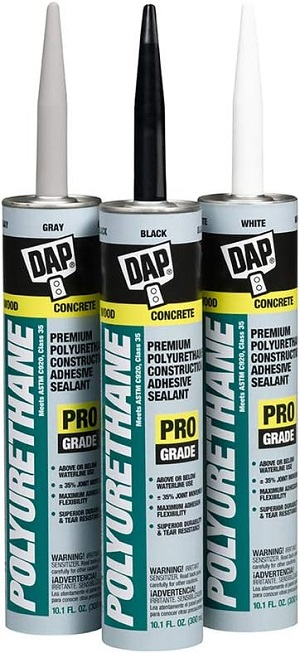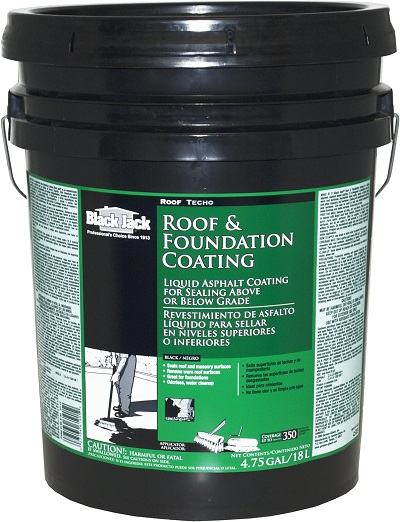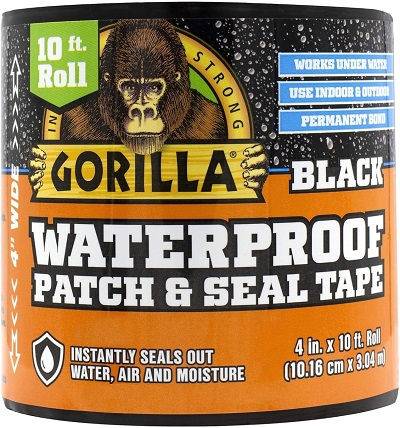Roof sealants are used to protect and seal roofs from water penetration, weather, and other external elements. We typically apply roof sealant to joints, seams, cracks, and other areas of a roof that can potentially leak, which helps to prevent water damage and extend the life of the roof.
Roof sealants are crucial for the integrity of your roof, so it’s important to select the best roof sealant for the job. Here we’ll explain the different types of roof sealants and what we look for when selecting the best roof sealant. We’ll also share our favorite roof sealants for various types of roofing and different roofing needs.
For excellent durability and flexibility, we turn to Countryman Coatings Silicone Top Coat. It’s 100% silicone that adheres securely to all surfaces, such as metal, modified bitumen, concrete, and even other sealant materials like acrylic, silicone, elastomeric, and urethane coatings. It can be applied using a roller, brush, or spray gun, and in most cases, it doesn’t require a primer. It’s a truly versatile option for both pros and DIY-ers.
In this article:
- What is Roof Sealant?
- Types of Roof Sealants
- What We Look for in the Best Roof Sealant
- The Best Roof Sealants of 2024
- Frequently Asked Questions
What is Roof Sealant?
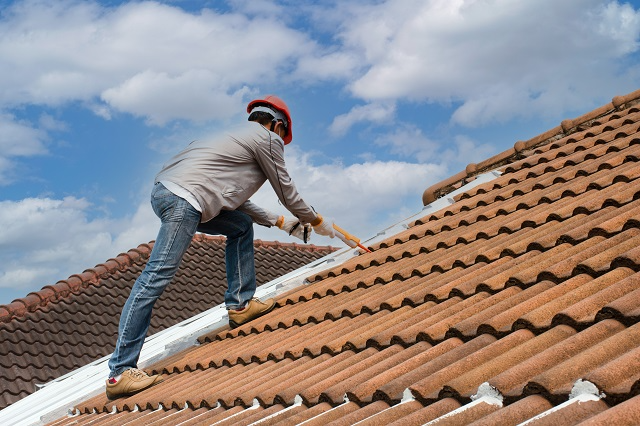
Roof sealant is a protective adhesive coating we use to help prevent leaks and extend the life of your roof. We use it for both roof repairs and new roofing installations and replacements.
For example, we apply roof sealant around vents, chimneys, and other areas that are prone to water pooling. This creates a watertight barrier that prevents water from seeping into your roof and causing costly damage.
Types of Roof Sealants
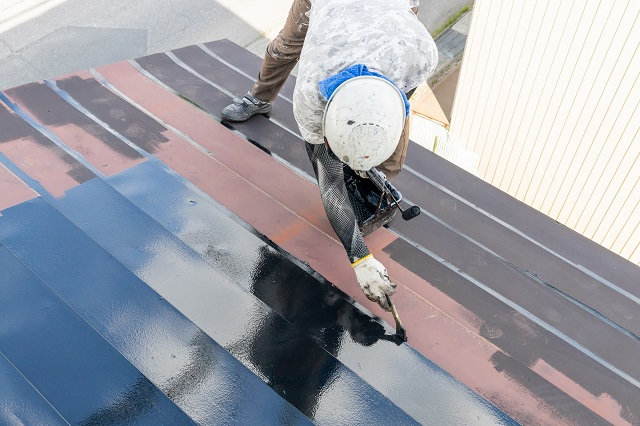
Roofing sealants come in various types, including silicone, polyurethane, acrylic, rubber, and tar-based sealants. Each type has its specific properties and suitable applications, with some being more flexible, durable, or weather-resistant than others.
Before we break down the different types of roof sealants, however, let’s talk about categories. Roof sealants fall into one of two primary categories:
Water-based Roof Sealants
Water-based roof sealants use water as a base, giving the sealant a thin consistency that makes it easy to apply. They’re particularly useful for filling small cracks for that reason. However, these roof sealants can’t be applied in cold weather because it will slow the curing process. Should the temperature dip below freezing, the sealant can actually freeze before it dries.
They’re not as resistant to outdoor elements (like UV rays and moisture) as solvent-based roof sealants, meaning they may need to be reapplied more frequently. They also take longer to cure compared to solvent-based sealants, but they’re considered the more environmentally friendly option as they have lower volatile organic compounds (VOC) emissions.
Solvent-based Roof Sealants
Solvent-based roof sealants use another medium, such as mineral spirits, as the base. They cure faster than water-based sealants and are more resistant to outdoor elements, but they require more careful application. That said, they can be applied in a wider range of temperatures.
They’re usually more expensive than water-based sealants, but they don’t need to be reapplied as often, so they can actually be more affordable in the long run. These roof sealants have higher VOC emissions, making them less environmentally friendly. They also tend to give off strong odors during application that can cause dizziness, headaches, and other symptoms. However, this is less of an issue in well-ventilated areas.
Roof sealants also come in various forms for different application methods, including liquid roof sealant, caulk sealant, roof sealant sprays, and roof sealant tape. Most types of roof sealants are available in multiple options.
The table below includes the most common types of roof sealants, their formulation, application methods, and other important details to know.
| Roof Sealant Type | Formulation | Application Methods | Key Features & Specs |
|---|---|---|---|
| Silicone Roof Sealant | Available in solvent-based and water-based formulations |
|
|
| Acrylic Roof Sealant | Water-based |
|
|
| Rubber Roof Sealant | Available in solvent-based and water-based formulations |
|
|
| Polyurethane Roof Sealant | Solvent-based |
|
|
| Asphalt (Bitumen) Roof Sealant | Available in solvent-based and water-based formulations |
|
|
| Sealant Tape | N/A | No special tools or equipment required |
|
What We Look for in the Best Roof Sealant
Selecting the right roof sealant is crucial in maintaining the integrity of your roof and protecting your home from water damage. When we’re choosing a roof sealant for a customer’s roof installation or repair, we consider the following factors.
- Type of roofing material: Different roof sealants are designed for different roofing materials, such as asphalt, metal, tile, or rubber. Ensure the sealant you choose is compatible with your roof type to ensure proper adhesion and effectiveness.
- Weather resistance: One of the most important features to consider when choosing a roof sealant is its ability to withstand various weather conditions. We look for roof sealants that are UV-resistant, waterproof, and can withstand extreme temperatures.
- Flexibility: Roofs expand and contract with changes in temperature, so it’s important to choose a sealant that is flexible and can move with the roof without cracking or breaking. That’s why we look for roof sealants that are specifically designed for roofing applications and maintain their flexibility over time.
- Adhesion: The best roof sealants have strong adhesion to various roofing materials such as shingles, metal, and concrete. We look for roof sealants that form a strong bond with the roof surface. A strong seal helps to prevent roof leaks and water damage.
- Durability: We select roof sealants that are durable and long-lasting to protect your roof for years to come. In addition to weather resistance (as we discussed above), we look for sealants that are resistant to mold, mildew, and other environmental factors that can degrade the sealant over time. More durable sealants don’t need to be reapplied as frequently, so while they can be more expensive upfront, they may actually save you money over time.
- Application method: It’s also important to consider how we want to apply the roof sealant, which depends on what areas of the roof we intend to apply it to, the roof’s condition, and other factors. Some sealants come in cartridges that can be applied with a caulking gun, while others come in buckets that can be applied with a brush or roller. If you’re selecting a roof sealant for a DIY project, look for a sealant that’s easy to apply.
- Cure time: Different roof sealants have different cure times, ranging from a few hours to a few days. This comes into play in certain climates during different times of the year. For example, slow-curing sealants are not ideal where it could rain before the sealant fully cures or where the temperature is likely to dip below freezing before it’s fully set.
- Warranty: The best roof sealants are backed by a warranty against product defects and certain issues. Roofing mishaps can be expensive, so it’s worth having the added peace of mind.
The Best Roof Sealants of 2024
Best Silicone Roof Sealant: Countryman Coatings Silicone Top Coat
For versatility and durability, we rely on Countryman Coatings Silicone Top Coat. It’s 100% silicone that adheres securely to all surfaces, including:
- Metal
- Modified bitumen
- EPDM
- Gravel surface built-up
- Smooth surface built-up
- Single-ply like PVC and TPO
- Concrete
- Spray foam
- Acrylic coatings
- Elastomeric coatings
- Other silicone coatings
- Urethane coatings
It can be applied with a brush, roller, or spray gun, and in most situations, this roof sealant doesn’t require a primer. Still, it far exceeds building code adhesion requirements for almost every roof surface. Designed to resist standing water, this roof sealant is suitable for the most demanding applications and is an excellent option for stopping roof leaks. If your roof has flat surfaces or is prone to ponding water, this is the sealant for you.
Countryman Coatings Silicone Top Coat comes in various colors, such as black, white, and gray, and it reflects almost 90% of UV rays, which helps to keep your home cool, which can reduce your cooling costs and cut your energy consumption by up to 20%. The coating is flexible to adapt to your roof’s movements, so it’s less likely to crack over time, even if you live in an area where the temperatures fluctuate significantly.
This professional-grade silicone roof coating can be applied in one thick coat, compared to other roof sealants that require multiple coats. We typically use about one gallon for every 55 square feet of roof surface area, depending on the roof substrate. Because it requires fewer coats, it also takes less time.
Countryman Coatings Silicone Top Coat comes in 1, 3, and 4.75 gallon buckets, so you don’t need to purchase more than you need to get the job done, meaning less waste. Designed to last for decades, this silicone roof sealant is backed by a 50-year material warranty.
Best Acrylic Roof Sealant: Gardner STA-Kool SK-7705 Traditional Acrylic Elastomeric Roof Coating
If you’re looking for a water-based option, we like Gardner’s STA-Kool Elastomeric Coating. It’s a flexible, acrylic latex coating that resists cracking and peeling over time and protects roof surfaces for up to 7 years.
This roof sealant expands and contracts up to 250%, so it’s great for areas that experience fluctuating temperatures that can cause your roof to expand and contract. It also has 85% reflectivity for UV rays, and it helps to keep your roof surface cool, which can result in lower cooling costs.
While it’s easy to apply with a roller or paint sprayer, there are some caveats and limitations. Your roof’s surface and the air temperature must be at least 50 degrees Fahrenheit before applying this sealant. It requires at least two coats, and you need to allow 24 hours between coats. This sealant takes 24 to 48 hours to fully cure.
The STA-Kool Elastomeric Coating should not be used if rain or heavy dew is expected within the curing period (24-48 hours), and it can’t be used on flat surfaces, areas with poor drainage, or anywhere prone to water ponding. It also can’t be used on surfaces that have been coated with aluminum, tar, or asphalt until that coating has been allowed to cure for at least one full summer season.
On traditional roofing surfaces, we can cover about 50 to 75 square feet with one gallon, and on metal roofs, we can cover about 75 to 100 square feet with one gallon of sealant. However, keep in mind that all surfaces will require at least two full coats.
Best Rubber Roof Sealant: Liquid Rubber Waterproof Sealant
Another water-based roof sealant, Liquid Rubber Waterproof Sealant is suitable for indoor and outdoor use. It provides a protective finish on a variety of surfaces, including flat roofs and metal roofs. With no solvents and ultra-low to no VOCs, it’s a safe and environmentally friendly option.
When fully cured, the final membrane has more than 1,000% elongation to prevent adhesion failure. It’s also UV-stable, meaning exposure to sunlight won’t degrade it over time.
While you’ll likely need more than one coat of this roof sealant, you don’t have to wait ages between coats. You can apply a second or any subsequent coats as soon as the treated surface is dry to the touch and uniform in color. We recommend applying multiple coats to any surface to ensure the best protection.
Liquid Rubber Waterproof Sealant is easy to apply and has a nice thick consistency that provides excellent coverage. You may not need as much of this product as you think you will. We easily cover about 15 square feet per gallon with this sealant.
For an ultra-durable finished result, use Liquid Rubber Seam Tape or Liquid Rubber Geo-Textile over joints, seams, vents, gaps, skylights, and protrusion before applying the sealant. Liquid Rubber also sells a Waterproofing Kit with all the essentials for sealing a roof, including:
- 5 gallons of Liquid Rubber Waterproof Sealant
- 4-pack of 10.2 oz. Liquid Rubber Caulk
- A roll of 4×50″ Liquid Rubber Seam Tape
Best Polyurethane Roof Sealant: Dap 7079818816 18816 Polyurethane Construction Adhesive and Sealant
The Dap Polyurethane Construction Adhesive and Sealant is a high-performance commercial-grade sealant comes in caulk tubes that work with most standard caulk guns. It does require some hand strength to use it with a caulk gun. If you don’t have a caulk gun, the Newborn 930-GTD Caulking Gun and the KLRStec Professional Caulking Gun are good options to consider.
Warming it up a bit makes it easier to squeeze out of the tube. That said, it’s generally easy to apply and is paintable, although it does have a fairly strong odor.
This roof sealant should be applied in temperatures of at least 40 degrees Fahrenheit and no more than 100 degrees Fahrenheit. Once fully cured, which takes 4 to 7 days, it performs in a wide range of temperatures, from -40 degrees to 170 degrees Fahrenheit. It remains permanently flexible, with a firm, rubber-like consistency when fully cured.
Dap Polyurethane Construction Adhesive and Sealant offers excellent adhesion to a variety of substrates, including wood, concrete, brick, metal, vinyl, aluminum, fiberglass, and steel. It forms a 100% waterproof seal and even holds up in permanent water submersion.
This roof sealant is ideal for use on shingles, gutters, chimneys, ducts, and skylights. With superior durability and flexibility, it’s capable of withstanding joint movements of around 35%. It also resists impacts, cuts, and thermal expansions.
It’s actually backed by a 50-year durability guarantee, so you can have confidence that this sealant will stand the test of time. Dap also makes an asphalt sealant in caulk form, the Dap 18268 Roof Waterproof Asphalt Filler and Sealant.
Best Asphalt Roof Sealant: Black Jack 6190 Roof and Foundation Liquid Asphalt Coating
Black Jack 6190 Roof and Foundation Liquid Asphalt Coating is a high-quality asphalt roof sealant. Instead of a caulk tube, it comes in a fiber-reinforced liquid formulation, so it’s easy to apply with a brush or roller.
It’s also odor- and solvent-free, but it’s designed for external use only. In addition to renewing and protecting worn roof surfaces, it’s also a good product for protecting exterior foundation walls.
When using Black Jack 6190 Roof and Foundation Liquid Asphalt Coating, plan for a warm day when there’s no rain in the forecast for at least 24 hours. The surface temperature of your roof must be between 50 and 120 degrees Fahrenheit before applying this roof sealant.
If the outdoor temperature is less than 50 degrees Fahrenheit, you’ll need to keep the product in a heated space (70 to 80 degrees Fahrenheit) for 24 hours before applying it so that it spreads more easily over your roof. If you plan on coating this sealant with a reflective coating, allow it to cure for 30 to 60 days before doing so.
In general, you can get about 50 square feet of coverage per gallon out of this roof sealant, but it varies depending on the porosity of the surface you’re coating. Black Jack has a handy online calculator to help you determine how much to buy.
Best Sealant Tape: Gorilla Waterproof Patch & Seal Tape
Gorilla Waterproof Patch & Seal Tape is made of thermoplastic olefin (TPO) with an extra thick adhesive layer and UV-resistant backing, and it’s available in black, white, and clear. This flexible tape conforms to surfaces, creating a permanent bond and instantly sealing out water, air, and moisture. It’s 4 inches wide, and one roll has 10 feet of tape.
Designed for both indoor and outdoor use, it’s great for repairing roof leaks and patching holes, cracks, gaps, and tears in a variety of smooth and non-porous surfaces, such as metal, aluminum, steel, acrylic, vinyl, plastic, rubber, wood, glass, and more. However, it doesn’t work well on water-repellent materials or silicone, and it’s not meant for use on seams or applications under pressure.
It even works underwater, so after you’ve tended to your roof sealing needs, you can use it for other tasks like patching your pool liner. It’s easy to apply even in hot, cold, wet, or dry conditions. For the best results, though, apply it to a clean surface at room temperature.
Another thing to keep in mind is that when you remove the liner to reveal the sticky side of the tape, you should be ready to apply it to the surface immediately. That’s not because it will lose its stickiness but because the moment it touches something, it adheres strongly on contact. If the tape folds over on itself, that piece is done for, and if it catches on something else other than the intended surface, getting it off will be a challenge, to say the least.
If you do use it in wet or underwater conditions, press all the water out from underneath the tape after applying it to the surface. Keep in mind that Gorilla Waterproof Patch & Seal tape is designed to bond permanently to surfaces, so it can damage surfaces or paint if you attempt to remove it.
Frequently Asked Questions
When should I use roof sealant?
Roof sealant is an important component of regular roof maintenance. It should be used when you need to prevent water leaks, improve weather resistance, or extend the life of your roof. It’s ideal for use after detecting minor cracks or gaps, during routine roof maintenance, or after installation of a new roof to protect against future damage.
Will roof coating stop leaks?
Yes, roof coatings can stop existing leaks and prevent new ones, provided the coating is appropriately applied to a clean, prepared surface. They are most effective on small, superficial leaks and may not be suitable for major or structural damage which might require professional repair.
What are the disadvantages of roof sealant?
Disadvantages of roof sealant include the potential for improper application, which can lead to ineffective sealing, the need for reapplication over time, and possible incompatibility with certain roofing materials. Additionally, some sealants may not perform well in extreme weather conditions.
What is the longest-lasting roof sealant?
Silicone-based roof sealants are generally considered the longest-lasting, often effective for up to 15-20 years. Silicone is highly resistant to weathering, extreme temperatures, and UV light, making it a durable choice for long-term protection.
Our top pick, Countryman Coatings Silicone Top Coat, is designed to last for decades and is backed by a 50-year material warranty.
What is better acrylic or silicone roof coating?
The choice between acrylic and silicone roof coating depends on the specific needs of your roof. Acrylic coatings are water-based, cost-effective, and environmentally friendly, suitable for climates with mild, dry conditions. You’ll typically need to apply multiple coats of acrylic roof coating.
Silicone coatings offer excellent flexibility, superior water resistance, and durability, making them better for areas with heavy rainfall and extreme weather conditions. Silicone roof coating is more expensive upfront but often requires fewer coats and is considered the most durable and longest-lasting option.


